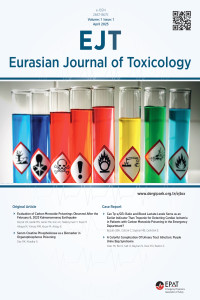Öz
Kaynakça
- Eichhorn L, Thudium M, Jüttner B. The Diagnosis and treatment of carbon monoxide poisoning. Dtsch Arztebl Int. 2018;115(51-52):863-70. doi: 10.3238/arztebl.2018.0863.
- Kinoshita H, Türkan H, Vucinic S, Naqvi S, Bedair R, Rezaee R, et al. Carbon monoxide poisoning. Toxicol Rep. 2020;7:169-73. doi: 10.1016/j.toxrep.2020.01.005.
- Pan KT, Shen CH, Lin FG, Chou YC, Croxford B, Leonardi G, et al. Prognostic factors of carbon monoxide poisoning in Taiwan: a retrospective observational study. BMJ Open. 2019;9(11):e031135. doi: 10.1136/bmjopen-2019-031135.
- Kandiş H, Katirci Y, Karapolat BS. Karbonmonoksit zehirlenmesi. Duzce Med J. 2009;11(3):54-60.
- Liao WC, Cheng WC, Wu BR, Chen WC, Chen CY, Chen CH, et al. Outcome and prognostic factors of patients treated in the intensive care unit for carbon monoxide poisoning. J Formos Med Assoc. 2019;118(4):821-7. doi: 10.1016/j.jfma.2018.09.005.
- Inoue S, Saito T, Tsuji T, Tamura K, Ohama S, Morita S, et al. Lactate as a prognostic factor in carbon monoxide poisoning: a case report. Am J Emerg Med. 2008;26(8):966.e1-3. doi: 10.1016/j.ajem.2008.01.048. doi: 10.1016/j.ajem.2008.01.048.
- Özkoç M, Aksakal E, Derman ÖF, Saraç I, Koza Y. Predictive value of cardiovascular risk scoring systems for the detection of myocardial injury following carbon monoxide intoxication. Turk J Emerg Med. 2023;23(1):30-7. doi: 10.4103/2452-2473.366483.
- Koga H, Tashiro H, Mukasa K, Inoue T, Okamoto A, Urabe S, et al. Can indicators of myocardial damage predict carbon monoxide poisoning outcomes?. BMC Emerg Med. 2021. https://doi.org/10.1186/s12873-021-00405-7.
- Akilli NB, Akinci E, Akilli H, Dundar ZD, Koylu R, Polat M, et al. A new marker for myocardial injury in carbon monoxide poisoning: T peak–T end. Am J Emerg Med. 2013;31(12):1651-5. doi: 10.1016/j.ajem.2013.08.049.
- Uyar EB, Uyar HG, Köylü R, Akilli NB, Köylü Ö. Yoğun bakımda takip edilen karbonmonoksit zehirlenmeli hastalarda COHb, Troponin I ve Laktat düzeylerinin prognoza etkisi. J Med Sci. 2023;4(1):30-41. https://doi.org/10.46629/JMS.2023.104
Can Tp-e/QTc Ratio and Blood Lactate Levels Serve as an Earlier Indicator Than Troponin for Detecting Cardiac Ischemia in Patients With Carbon Monoxide Poisoning in the Emergency Department?
Öz
Abstract: Carbon monoxide (CO) poisoning is a clinical condition with serious cardiotoxic effects. This study compares two cases of CO poisoning to evaluate whether Tp-e/QTc ratio and blood lactate levels can serve as earlier indicators of cardiac ischemia than troponin levels. Two male patients, aged 37 and 47, who presented to the emergency department due to CO exposure, were analyzed. Their electrocardiographic (ECG) parameters, troponin levels, and lactate values were compared. Additionally, the clinical course of both patients was assessed.
In the first case (37 years old), ST depression in leads V1-V6 was detected on ECG, and troponin levels showed a progressive increase. Coronary angiography revealed no significant narrowing of the epicardial coronary arteries. The patient’s QTc interval was 481 ms at admission, Tp-e duration was 79 ms, and Tp-e/QTc ratio was 0.16. Upon discharge, these values returned to normal. The second case (47 years old) had normal ECG and laboratory findings and was discharged without complications. Furthermore, in the first case, lactate levels were significantly higher at admission and remained elevated for a prolonged period.
Minimal QTc prolongation and a significant increase in lactate levels following CO poisoning may serve as early indicators of cardiac ischemia. Despite normal troponin levels, the first case required further cardiac evaluation. These findings suggest that monitoring QTc and lactate levels may help in the early detection of cardiac involvement in CO poisoning. However, further research is required to establish the prognostic value of these markers.
Anahtar Kelimeler
Carbon monoxide poisoning Cardiac ischemia Tp-e/QTc ratio Blood lactate level Electrocardiography.
Kaynakça
- Eichhorn L, Thudium M, Jüttner B. The Diagnosis and treatment of carbon monoxide poisoning. Dtsch Arztebl Int. 2018;115(51-52):863-70. doi: 10.3238/arztebl.2018.0863.
- Kinoshita H, Türkan H, Vucinic S, Naqvi S, Bedair R, Rezaee R, et al. Carbon monoxide poisoning. Toxicol Rep. 2020;7:169-73. doi: 10.1016/j.toxrep.2020.01.005.
- Pan KT, Shen CH, Lin FG, Chou YC, Croxford B, Leonardi G, et al. Prognostic factors of carbon monoxide poisoning in Taiwan: a retrospective observational study. BMJ Open. 2019;9(11):e031135. doi: 10.1136/bmjopen-2019-031135.
- Kandiş H, Katirci Y, Karapolat BS. Karbonmonoksit zehirlenmesi. Duzce Med J. 2009;11(3):54-60.
- Liao WC, Cheng WC, Wu BR, Chen WC, Chen CY, Chen CH, et al. Outcome and prognostic factors of patients treated in the intensive care unit for carbon monoxide poisoning. J Formos Med Assoc. 2019;118(4):821-7. doi: 10.1016/j.jfma.2018.09.005.
- Inoue S, Saito T, Tsuji T, Tamura K, Ohama S, Morita S, et al. Lactate as a prognostic factor in carbon monoxide poisoning: a case report. Am J Emerg Med. 2008;26(8):966.e1-3. doi: 10.1016/j.ajem.2008.01.048. doi: 10.1016/j.ajem.2008.01.048.
- Özkoç M, Aksakal E, Derman ÖF, Saraç I, Koza Y. Predictive value of cardiovascular risk scoring systems for the detection of myocardial injury following carbon monoxide intoxication. Turk J Emerg Med. 2023;23(1):30-7. doi: 10.4103/2452-2473.366483.
- Koga H, Tashiro H, Mukasa K, Inoue T, Okamoto A, Urabe S, et al. Can indicators of myocardial damage predict carbon monoxide poisoning outcomes?. BMC Emerg Med. 2021. https://doi.org/10.1186/s12873-021-00405-7.
- Akilli NB, Akinci E, Akilli H, Dundar ZD, Koylu R, Polat M, et al. A new marker for myocardial injury in carbon monoxide poisoning: T peak–T end. Am J Emerg Med. 2013;31(12):1651-5. doi: 10.1016/j.ajem.2013.08.049.
- Uyar EB, Uyar HG, Köylü R, Akilli NB, Köylü Ö. Yoğun bakımda takip edilen karbonmonoksit zehirlenmeli hastalarda COHb, Troponin I ve Laktat düzeylerinin prognoza etkisi. J Med Sci. 2023;4(1):30-41. https://doi.org/10.46629/JMS.2023.104
Ayrıntılar
| Birincil Dil | İngilizce |
|---|---|
| Konular | Acil Tıp |
| Bölüm | Case Reports |
| Yazarlar | |
| Yayımlanma Tarihi | 30 Nisan 2025 |
| Gönderilme Tarihi | 21 Şubat 2025 |
| Kabul Tarihi | 25 Nisan 2025 |
| Yayımlandığı Sayı | Yıl 2025 Cilt: 7 Sayı: 1 |


